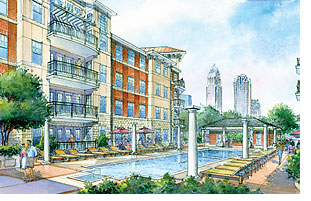Charlotte a destination for affordability

That is… attainable housing that doesn’t look like subsidized affordable housing. For example, homes in The Renwick (pictured) are said to be starting in the mid-100Ks. Seems to be a great example of no-frills chic.
The area’s overall cost of living is 3% below the national average, yet the median home price in Charlotte is $169,400, about 10% below the national average, according to the National Association of Realtors. What’s surprising is that people are making more money than the national average – the median household income of $49,228 in 2004 was 11.8% above the U.S. average. What gives?
As I’ve stated time and again, it’s simple supply and demand. Charlotte is meeting the demand with a tremendous boom of housing construction in the downtown that’s boosting the population from near non-existent in the early 90s toward 10,000 today. Even so, some local experts say the demand still isn’t being met, and that the median home price overall is staying low because single-family homes in the outskirts are becoming less desirable.
How important is affordability in the downtown to you? Speak your mind below…

I recently spent some time in Charlotte and received a rundown on the development taking place there by my brother-in-law, who is a long-time resident and landscape architect with a planning and design firm there.
Certainly they are making substantial progress in turning a very suburban city, dominated by a few large banks and institutions, into a more urban and diverse place.
The real estate market is substantially more affordable than what we have here in the Washington DC area. In part it may be due to significant new development in areas 10 to 20 miles north and south of the city center. Although sprawl is a bad thing, some of the developers seem to adopted the new urbanist design template for their housing development. There are pockets of walkable communities (including downtown) being built within a large mostly auto-oriented metropolitan area.
Having affordable housing in combination with a land use pattern and transportation system that enables persons to go car-less is really the key. We all can pay a little more for housing if we do not have to own a second, or any car.